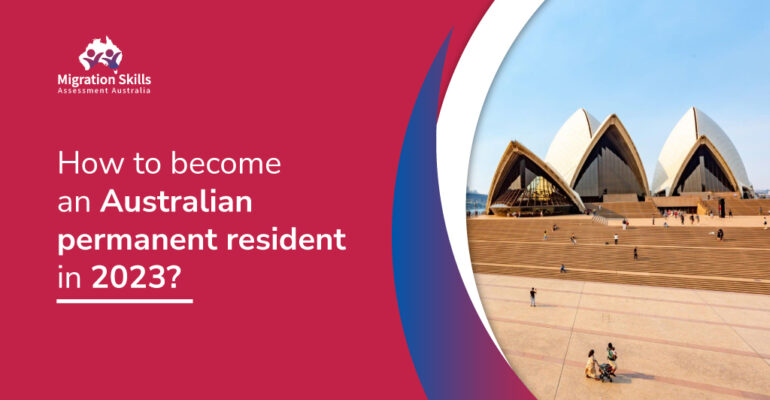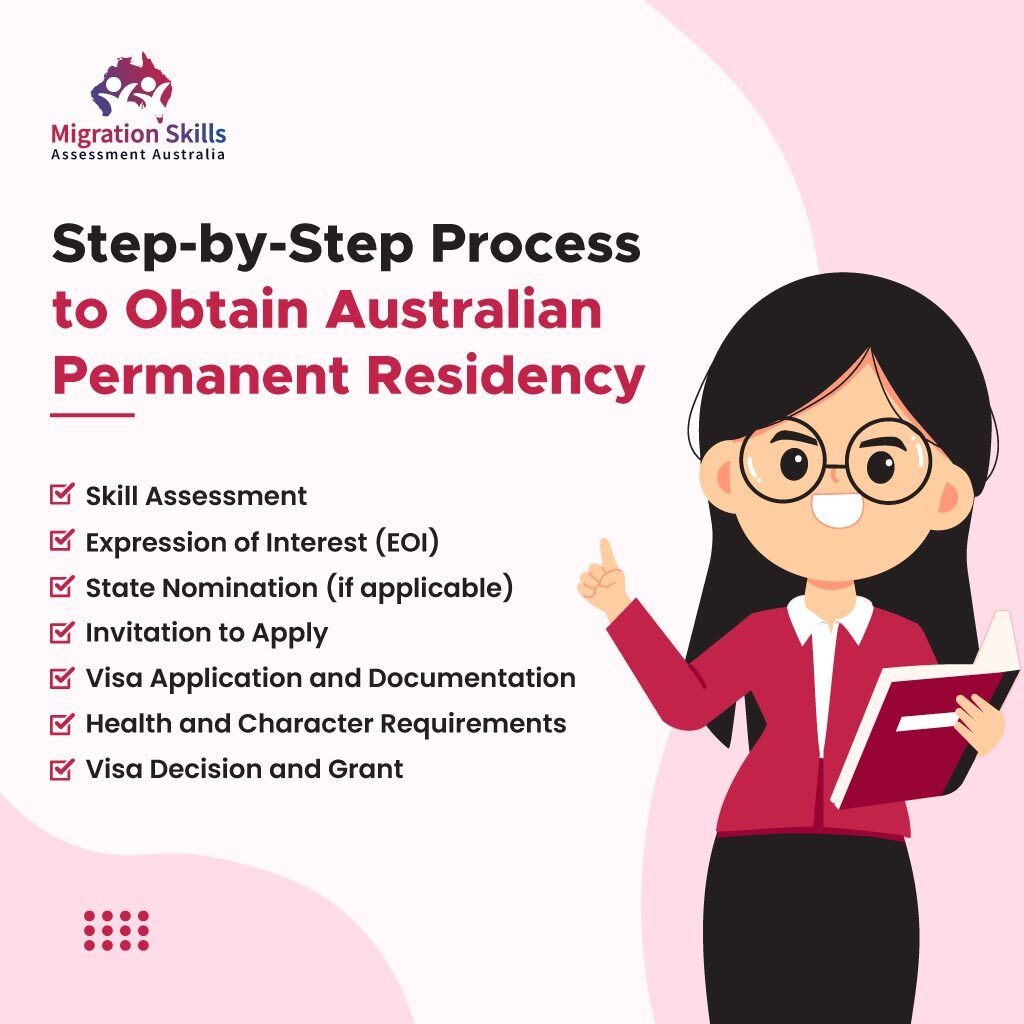How to become an Australian permanent resident in 2023?

How to become an Australian permanent resident in 2023?
Obtaining Australian permanent residency in 2023 continues to be a sought-after goal for individuals seeking a new life and opportunities in Australia. With its robust economy, high standard of living, and diverse culture, Australia offers a welcoming environment for those looking to settle and establish themselves in the country.
This blog will take you through the various pathways available, eligibility criteria, and step-by-step processes to help you navigate the journey of becoming an Australian permanent resident.
Australian Permanent Residency
Understanding the concept of Australian permanent residency is essential when considering a move to Australia. Australian permanent residency is the immigration status that permits every individual to live and work in the country indefinitely.
It provides numerous benefits, including access to healthcare, education, social security, and the ability to sponsor family members for migration. Permanent residency also offers a pathway to Australian citizenship after meeting specific requirements.
As an Australian permanent resident, you can reside in Australia without any time restrictions. It means you can come and go from the country as you please, making it a highly flexible immigration status.
However, it’s important to note that permanent residency does not grant voting rights in federal elections or an Australian passport. To acquire these privileges, individuals need to apply for Australian citizenship.
Obtaining permanent residency is a significant milestone for individuals who wish to settle in Australia long-term. It opens up a range of employment, education, and lifestyle opportunities. Australia’s strong economy, high standard of living, and multicultural society make it an attractive destination for individuals seeking stability and growth.
Eligibility Criteria for Australian Permanent Residency
To be eligible for Australian permanent residency, individuals must meet specific criteria set by the Australian government. These criteria include age, skills, qualifications, work experience, English language proficiency, and health and character requirements.
Age requirements vary depending on the visa subclass. Generally, individuals under 45 are eligible for most skilled migration pathways. However, certain exemptions exist for certain occupations or regional sponsorships.
Skills assessment is a critical step in the permanent residency process. It involves assessing an individual’s qualifications and work experience to determine if they meet the standards required for their nominated occupation. Skills assessment authorities get designated for each occupation, and individuals must provide evidence of their qualifications and experience to obtain a positive assessment.
Proficiency in the English language is also an essential factor in becoming an Australian permanent resident. Most visa subclasses require individuals to demonstrate competent English language skills, which can get proven through recognized English language tests such as IELTS or TOEFL.
Health and character requirements are in place to ensure that individuals entering Australia do not pose a risk to public health or safety. Medical examinations and police clearances are typically required to demonstrate good health and character.
Meeting these eligibility criteria is crucial for a successful permanent residency application. It is paramount to thoroughly understand the requirements for the visa subclass set by Engineers Australia you are applying for and provide accurate and complete documentation to support your claims.
Skilled Migration Pathways
Skilled migration is a popular pathway for individuals seeking Australian permanent residency. Australia has a strong demand for skilled workers in various industries, and the government has established several visa subclasses to attract individuals with the required skills and qualifications.
a. Skilled Independent Visa (Subclass 189)
This Visa is a points-tested visa that allows skilled workers not sponsored by an employer, state, or territory government to permanently live and work in Australia. To be eligible for this Visa, individuals must submit an Expression of Interest (EOI) and get an invitation from the Department of Home Affairs.
b. Skilled Nominated Visa (Subclass 190)
This Visa is a state or territory-nominated visa that lets skilled workers live and work in a specific state or territory in Australia. To be eligible for this Visa, individuals must first submit an EOI and receive a state or territory government nomination.
c. Skilled Work Regional (Provisional) Visa (Subclass 491)
The Skilled Work Regional (Provisional) Visa (Subclass 491) is a points-tested visa that allows skilled workers to live as well as have some job in regional Australia for up to five years. This Visa requires either territory government nomination or sponsorship by an eligible family member residing in a designated restricted area.
Visit: How to make an ideal CV for a skills assessment? ✈️✈️
Employer-Sponsored Migration
a. Employer Nomination Scheme (Subclass 186)
The Employer Nomination Scheme (Subclass 186) is a pathway for skilled workers nominated by an Australian employer to become Australian permanent residents. This Visa requires a genuine job offer from an Australian employer and falls under the Direct Entry stream, Temporary Residence Transition stream, or Agreement stream.
The employer must meet specific requirements, including demonstrating a genuine need for the nominated position and offering market salary rates.
b. Regional Sponsored Migration Scheme (Subclass 187)
The Regional Sponsored Migration Scheme (Subclass 187) allows employers in regional areas of Australia to nominate skilled workers for permanent residency. This Visa addresses skill shortages in restricted areas and promotes regional development.
It comprises the Temporary Residence Transition, Direct Entry, and Agreement streams. Applicants must meet specific criteria, including age, English language proficiency, skills assessment, and health and character requirements.
Family-Sponsored Migration
a. Partner Visas
Partner visas are available for individuals in a genuine and ongoing relationship with an Australian citizen, permanent resident, or eligible New Zealand citizen. There are different subclasses of partner visas, including Subclass 820/801 (for onshore applications) and Subclass 309/100 (for offshore applications).
To be eligible, applicants must meet the relationship requirements and undergo a thorough assessment of their relationship with their Australian partner.
b. Parent Visas
Parent visas allow parents of Australian citizens, permanent residents, or eligible New Zealand citizens to live in Australia. These visas have different streams, including the Contributory Parent (Subclasses 173/143) and the Non-Contributory Parent (Subclasses 103/804).
Parent visas have specific requirements, including balance of family tests, health, and character checks, and financial obligations.
Business and Investment Migration
a. Business Innovation and Investment Visa (Subclass 188)
This Visa is for individuals who want to own and manage a business in Australia or make a significant investment in the country. This Visa has several streams, including Business Innovation, Investor, and Significant Investor. Each stream has different requirements related to business experience, investment funds, and other criteria.
b. Business Talent Visa (Subclass 132)
The Business Talent Visa (Subclass 132) is for high-caliber business owners and entrepreneurs who an Australian state or territory government agency nominates. This Visa has two streams: Significant Business History and Venture Capital Entrepreneur. Applicants must demonstrate a successful business career or high-level funding from a venture capital firm.
Other Pathways
a. Global Talent Visa (Subclass 858)
The Global Talent Visa (Subclass 858) is designed to attract highly skilled individuals in specific target sectors to work and live in Australia permanently, getting Australian Permanent Resident. It is an invitation-only visa that requires applicants to demonstrate exceptional talent in one of the target sectors identified by the Australian government.
b. Distinguished Talent Visa (Subclass 124/858)
The Distinguished Talent Visa (Subclass 124/858) is for individuals with exceptional achievements or outstanding skills in specific fields, including sports, the arts, academia, or research. This Visa requires nomination by an eligible individual or organization in Australia and is limited to a small number of individuals annually.
c. Temporary Graduate Visa (Subclass 485)
The Temporary Graduate Visa (Subclass 485) allows recent international graduates from Australian educational institutions to work in Australia temporarily. It provides a pathway for graduates to gain work experience and transition to permanent residency through skilled migration or employer sponsorship.
Visit: How to prepare a CDR report for engineers migrating to Australia? ✈️✈️
Step-by-Step Process to Obtain Australian Permanent Residency
Below is a step-by-step process to obtain Australian Permanent Resident:

a. Skill Assessment
The first step is to undergo a skill assessment conducted by the relevant assessing authority. This assessment verifies that your qualifications and work experience align with Australian standards and requirements for your nominated occupation.
b. Expression of Interest (EOI)
Once you have a positive skill assessment, you must submit an Expression of Interest (EOI) through the online platform SkillSelect. The EOI provides information about your skills, qualifications, and experience and indicates your interest in obtaining Australian permanent residency.
c. State Nomination (if applicable)
If you are applying for a visa requiring state or territory nomination, you must apply for a nomination from the relevant state or territory government. Each state or territory has its specific criteria and requirements for nomination.
d. Invitation to Apply
Based on the information provided in your EOI and the availability of positions, you may receive an invitation to apply for a specific visa subclass. Invitations are issued periodically by the Department of Home Affairs; receiving an invitation is a critical step in the process.
e. Visa Application and Documentation
Once you have received an invitation, you can proceed with the visa application. This Visa involves completing the necessary forms, providing supporting documentation, and paying the application fee. The documentation typically includes identity documents, proof of English language proficiency, skill assessment results, health examinations, and character clearances.
f. Health and Character Requirements
As part of the visa application process, you must meet the health and character requirements designated by the Australian government. This requirement includes undergoing medical examinations to assess your health and obtaining police clearances from the countries you have resided in.
g. Visa Decision and Grant
After submitting your application, it will get assessed by the Department of Home Affairs. The department will review your documentation, conduct any necessary checks, and decide on your visa application. If approved, You will receive a visa grant letter confirming your Australian permanent residency.
Additional Considerations for Australian Permanent Resident
a. Points-Based System
Many visa subclasses for skilled migration utilize a points-based system to assess eligibility. Points get awarded based on age, English language proficiency, qualifications, work experience, and other criteria. Meeting the points threshold is crucial to be eligible for specific visa subclasses.
b. English Language Proficiency
English language proficiency is often required to obtain an Australian permanent residency. This requirement can get done through recognized English language tests such as IELTS or TOEFL.
c. Skills Occupation Lists
Visa subclasses may have specific occupation lists, such as the Medium and Long-term Strategic Skills List (MLTSSL) or the Regional Occupation List (ROL). These lists determine which occupations are eligible for skilled migration and can impact the visa options available to you.
d. Health Insurance Requirements
Maintaining adequate health insurance coverage is vital for Australian permanent resident individuals. It ensures access to healthcare services and helps cover medical expenses.
e. Permanent Resident Obligations
As an Australian permanent resident, you have certain obligations, including adhering to Australian laws and maintaining a valid visa. Understanding and fulfilling these obligations is essential to keep your permanent residency status.
Essential Steps to Get PR Instantly:
- Prepare a decision-ready application.
Ensuring your application is complete, accurate, and well-documented can significantly speed up the processing time. Gathering all the required documents and information beforehand and submitting a decision-ready application can help expedite the process.
- Priority Migration Skilled Occupation List (PMSOL)
Keeping track of the Priority Migration Skilled Occupation List is essential. The PMSOL identifies occupations in high demand, and applications from individuals in these occupations may receive priority processing.
- Knowing how and when to contact the Department
Understanding when and how to get into the Department of Home Affairs can provide valuable information and assistance throughout the application process. Utilize the official channels and resources to stay updated and seek clarification when needed.
By following these steps and considering the additional factors, you can navigate the process of obtaining Australian permanent residency more effectively. It is crucial to familiarize yourself with the specific requirements of the visa subclass you are applying for and seek professional advice if needed.
Read more: Competency Demonstration Report(CDR): Everything you need to know 📑📑
Conclusion
Becoming an Australian permanent resident in 2023 is achievable with the proper knowledge and preparation. This comprehensive guide has provided an in-depth understanding of the various pathways, eligibility criteria, and step-by-step processes involved in obtaining Australian permanent residency.
Following the outlined steps and considering the additional factors can maximize your chances of a successful application. Remember, immigration policies and regulations can change over time, so staying informed and seeking professional advice or referring to official government sources for the most up-to-date information is crucial.
Embark on your journey towards Australian permanent residency with confidence, knowing that the opportunities and benefits await you in Australia make the endeavor worthwhile. Good luck on your path to becoming an Australian permanent resident!


